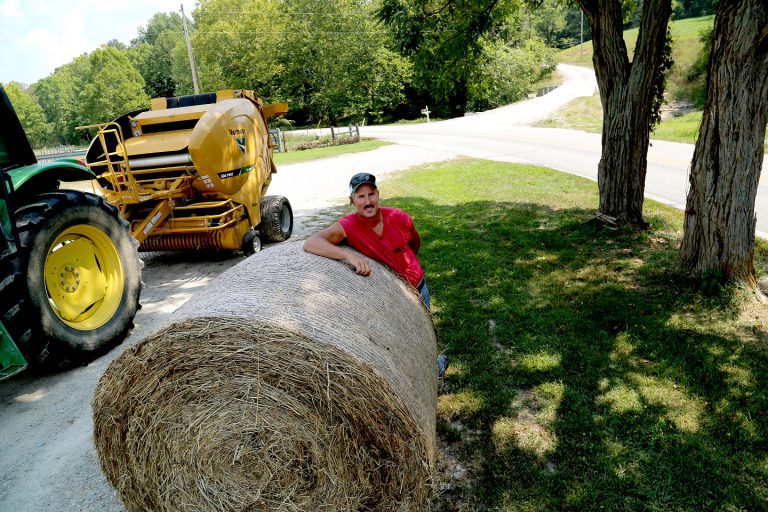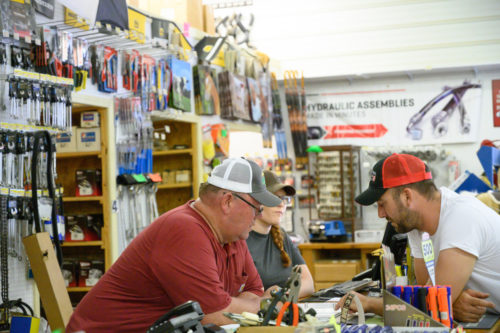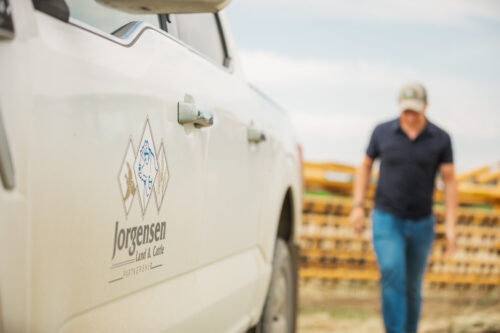
Baleage: The hottest thing in haymaking
November 2016
It’s the hottest thing in haymaking. For years, hay producers have obsessed over weather forecasts, watching with worried eyes as red digital rain clouds swept in their direction.
Ominous circles representing a great threat to the freshly cut hay that’s supposed to be drying in their fields. After all, nothing is more damaging to drying hay than moisture but, alas, perhaps moisture is what was missing from the equation all along.
Silage (also referred to as baleage; think bale plus silage) originated, by most reports, in Europe. Here in the states, however, it’s become an increasingly popular alternative for haymakers in traditionally wetter regions who have found it more and more difficult – if not impossible – to consistently make dry hay.
The moisture challenge
For years, Steve Riley battled against the conditions in a futile attempt to make dry hay for his cattle in Deputy, Indiana, only to be thrown off course by Mother Nature time and time again. Finally, with his patience stretched to a straw’s width, he decided to shift course entirely and use the omnipresent moisture to his own advantage.
“A lot of people call (this) God’s country, but it’s very hard to make dry hay here,” Riley says. “It can happen, but the windows of opportunity seem to be so short anymore that we just can’t seem to get anything done. Wet hay is something we’ve been playing with for the last 20 years. Now we’re pretty much 100 percent wet hay.”
In this part of the country, Riley isn’t alone in this line of thinking. The silage movement has its roots in the Midwest and Northeast, where producers have come to expect shorter periods of time between rainfalls.
Traditionally, making dry hay requires approximately five days of dry conditions between harvesting and baling, a tall order for areas with short windows of opportunity. With silage, Riley explained, the wait becomes an afterthought.
"When quality translates to better feed efficiency which, in turn, leads to better gain in beef cattle and increased milk production in dairy cattle, it makes sense that producers would want to maximize forage quality. Silage is a solid solution."
“The process of trying to hit the window to get enough dry days to get the hay dry and get it right is very hard to hit,” Riley says. “But with wet hay, we’re pretty much 24 hours from the time we cut hay until it’s wrapped up in a tube and done. There’s no battle. You just cut it, break it and bale it.”
The silage-making process, as Riley confirmed, is much more flexible and convenient than its dry haymaking sibling. But that’s only part of the story. In my experience, silage allows you to cut the crop when it’s at its highest quality rather than having to wait for a long stretch of dry weather and quality. Oftentimes producers are forced to wait too long to cut the hay, and the quality of the end product isn’t what it could be.
Quality is everything
When quality translates to better feed efficiency which, in turn, leads to better gain in beef cattle and increased milk production in dairy cattle, it makes sense that producers would want to maximize forage quality. Silage is a solid solution.
The leaves hold most of the protein content of the plant and because we often see less leaf loss when the material is wet, the wetter the forage, the higher the crude protein content will be.
Additionally, silage is more palatable for cows. Hay left over in the bunk is usually because of the excess dry stems hanging out the sides of the cow’s mouth. Put a silage bale next to a dry bale, and the silage bale will be completely gone before the cows even look at the dry bale; the material loss of silage bales is next to nothing.
The advantages to silage go beyond convenience in process and gains in production. The actual process of making silage also results in better yields.
According to research from the University of Wisconsin, for each day you drive over a field of alfalfa after it’s mowed, you’ll lose an average of 6 percent yield on the next cutting. Therefore, if you leave hay in the field five days to dry, you can expect up to 30 percent loss in yield on the next crop.
What makes silage so great
Silage can be made with anywhere from 25 to 70 percent moisture content. The exact percentage, in my opinion, is inconsequential. The key is getting the material wrapped in a timely manner (ideally less than 24 hours after mowing) so fermentation can occur and we cut off the oxygen supply.
The bacteria in that wrapped package excludes the oxygen, and it helps to convert the starches to sugar, which creates lactic acid. The combination of bacteria and lactic acid that forms during fermentation does not change the quality of the forage, but the acid acts as a preservative when it comes time to feed the bales.
The longer you wait to feed the bales after opening the package is where the quality changes can occur. The sooner you feed the baleage after opening the package, the better your quality will be.
The right machinery
Making hay is making hay. But if you’re going to be making primarily silage, I recommend using hay and forage tools designed for the added rigors of making silage. The first few questions you have to ask yourself are:
- What percentage of my hay is going to be silage?
- Can I get by with a baler designed for dry hay that can also do some wet hay?
Then I would look at how dense a bale that baler can make. The density of the bale is more important for silage bales than for dry hay because the more hay you get into a silage package, the less oxygen can get in, so you’ll have better fermentation.
For those, like Steve Riley, who are moving toward making silage exclusively, I recommend a baler that’s built for it from the ground up. Silage balers boast features that help with the added weight and challenges that come with baling a heavier, wetter crop.
For starters, silage balers are built to handle bales that weigh between 2,000 and 2,500 pounds, compared to dry hay balers that are typically meant to roll out bales weighing about 1,000 pounds.
In addition, most silage balers feature a pre-cutter system that trims full-length hay (1 to 2 feet tall) down to pieces 2.5 to 4 inches long. This enhances feed efficiency because cows only bite off what they can chew.

You’re really processing while you’re baling. By doing that, you add a lot of additional density and a higher palatability for the cattle, resulting in less feed loss.
Perhaps more importantly, a silage baler should also have a drop floor. If you’ve ever plugged a baler when the hay is dry, you’re looking at roughly 30 minutes, maybe more, to unplug the baler.
With silage, it gets even worse. It’s a wetter, stickier crop, so it’s even harder to unplug that baler if you plug it. With the drop floor feature, you can unplug the baler from the cab of the tractor in significantly less time.
Plugging is a serious issue for all hay producers but particularly those like Steve Riley who roll through wet material the majority of the time. Riley had grown accustomed to his baler plugging up, even while running at speeds as low as 2 to 3 miles per hour.
Since purchasing a baler designed specifically for silage, he said he’s been baling silage at speeds greater than 8 mph without any issues.
But more than that, Riley has enjoyed being able to work on his own clock instead of having to wait for clear skies.
“I don’t really even listen much to the weather anymore. If we’ve got a few days straight (of dry weather), or even 24 hours, I’m cutting hay,” Riley says.
These days he’s not alone. Silage is here to stay and quickly becoming the preferable option for producers everywhere who are tired of waiting on good weather and want a higher-quality forage for their cattle. When you put it that way, silage just makes sense.






